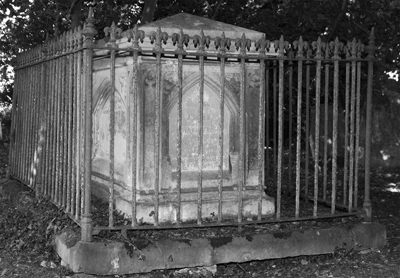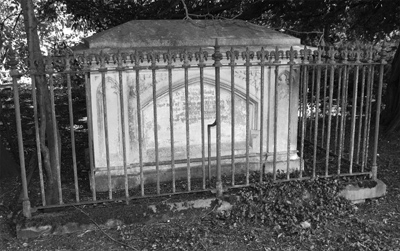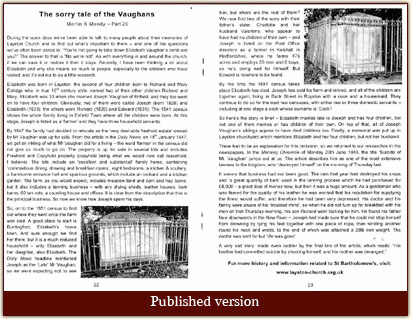Martin & Mandy


During the open days we've been able to talk to many people about their memories of Layston church and to find out what's important to them – and one of the questions we've often been asked is: "You're not going to take down Elizabeth Vaughan's tomb are you?". The answer to that is "No we're not" – as with everything in and around the church, if we can save it or restore it then it stays! Recently I have been thinking a lot about Elizabeth, and why she means so much to people, especially to the children that have visited, and it's led me to do a little research.
Elizabeth was born in Layston – the second of four children born to Richard and Mary Edridge who, in true 18th century style, named two of the other children Richard and Mary! Elizabeth married quite late – she was 33 when she married Joseph Vaughan of Enfield and they went on to have four children too, obviously two were called Joseph (1828), and Elizabeth (1833), the others were Richard (1826) and Edward (1831). The 1841 census shows the whole family living in Enfield Town where all the children were born. At this stage Joseph is listed as a farmer and they have 3 household servants.
By 1847 the family have obviously decided to relocate as the 'very desirable freehold estate' that Mr Vaughan owns is up for sale…. From the article in the Daily News on the 18th January 1847 we get an inkling of what Mr Vaughan did for a living – the word 'Farmer' in the census doesn't give us much to go on. The whole of the property is up for sale in several lots and includes Freehold and Copyhold property – copyhold being what we would now call leasehold I believe. The lots include an 'excellent and substantial' family home, containing 'commodious dining, drawing and breakfast rooms', eight bedrooms, a kitchen & scullery, a handsome entrance hall and spacious grounds, which include an orchard and a kitchen garden. The farm does include meadow land and corn and hay barns as you would expect, but it also includes a tanning business – with airy drying sheds, leather houses, bark barns, 60 tan vats, a counting house and offices. It's clear from the description that this is the principal business. So now we know how Joseph spent his days.
So, on to the 1851 census – and now we have to find out where they went once the farm was sold, and a good place to start is Buntingford, returning to Elizabeth's home town. Sure enough we find them there, but it is a much reduced household – only Elizabeth and her daughter, also called Elizabeth. The Daily News head line mentioned Joseph as the 'Late' Mr Vaughan so we were expecting not to see him – but where are the rest of them?
We find two of them with their father's sister Charlotte and her husband Valentine, who appear to have had no children of their own – and Joseph is now listed on the Post Office directory as a farmer in Kelshall in Hertfordshire, where he farms 475 acres and employs 20 men and 6 boys, so he's doing well for himself, but Edward is nowhere to be seen.
By the time the 1881 census takes place Elizabeth has died, Joseph has sold his farm and retired and all the children are together again, living in Back Street in Royston with a cook and a housemaid, and they continue to do so for the next two censuses, with either two or three domestic servants – including at one stage a cook whose surname is 'Cook'!
So here's the story in brief – Elizabeth marries late to Joseph, has four children, but not one of them marries and has children of their own.... On top of that, all of Joseph Vaughan's siblings appear to have died childless too, and a memorial has been put up in Layston churchyard which mentions Elizabeth, her four children, but not her husband…
There has to be an explanation for all of this … So our research goes to the newspapers, and in the Morning Chronicle on Monday the 20th June 1843 the title "Suicide of Mr. Vaughan" jumps out at us. The article describes him as one of the most extensive tanners in the kingdom, who 'destroyed himself' on the morning of Thursday last…
It seems that business had not been good – the rain that year had destroyed his crops and 'a great quantity of bark' used in the tanning process which he had purchased for £8000 - a great deal of money now, but then it was a huge amount.... As a gentleman who was famed for the quality of his leather he was worried that his reputation for supplying the finest would suffer, and therefore he had been very depressed. His Doctor and his family were aware of his 'troubled mind' so when he did not turn up for breakfast with his men on that Thursday morning his son Richard went looking for him. He was found face downwards in the New River – he had made sure that he couldn't stop himself from drowning by tying his feet together with one piece of rope then winding another round his neck and wrists, to the end of which was attached a 28lb iron weight – the doctor was sent for but 'life was gone'.
A very sad story, made even sadder by the final line of the article, which reads "His brother had committed suicide by shooting himself, and his mother was deranged."
 |
|
 |
